
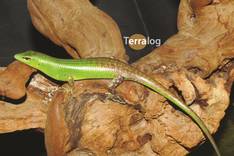 The skinks are a very species-rich and successful group of lizards. Their scales lie very tight to the body, giving them a smooth appearance. In addition many species gleam like freshly polished porcelain.
The skinks are a very species-rich and successful group of lizards. Their scales lie very tight to the body, giving them a smooth appearance. In addition many species gleam like freshly polished porcelain.
The first two species of skinks to be discussed here are specialized tree-dwellers. They were both formerly assigned to the genus Dasia, but nowadays the first of them, the Emerald Tree Skink, is assigned to the genus Lamprolepis and hence has the scientific name L. smaragdina. The second species, the Olive Tree Skink, which is more of a brown color, is the type species of the genus Dasia and named D. olivacea. Both species are at present being occasionally imported from Indonesia for the hobby. They grow to a total of around 25 cm long, with somewhat more than half the total length being represented by the tail.
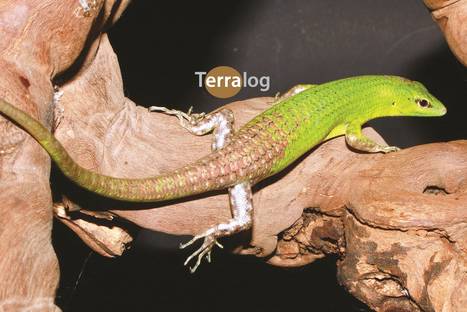
High, higher, highest
The skinks of the Dasia group are common in the wild and are very attractive in appearance. L. smaragdina in particular is a real classic among terrarium occupants, as its brilliant green is unrivalled. The color form shown here exhibits a particularly brilliant green. This form, in which the posterior third of the body is brown in color, is usually assigned to the subspecies Lamprolepis smaragdina philippinica. The nominate form is uniform green and likewise very beautiful. But Dasia olivacea is also a real eyecatcher, and as long as it is properly acclimatized the belly is brilliant green-yellow in color.
Because they are so common and so attractive, these lizards can often be obtained at low prices in the trade. But these lovely skinks will give you real pleasure only if you can house them in a very tall terrarium. Experienced keepers of these reptiles are fond of saying that a Dasia terrarium can never be tall enough! A terrarium up to 2 meters (standard room height) is sometimes recommended.
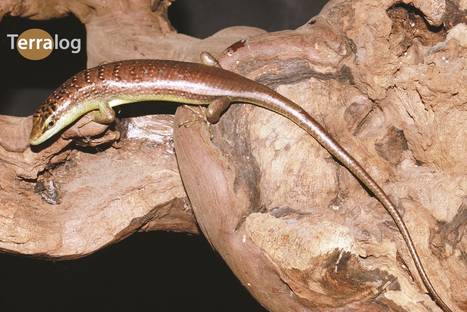
Now, it doesn’t need to be quite so tall, especially if the terrarium is suspended so that its upper rim is flush with the ceiling. Such a terrarium will also provide the skinks with the sensation of great height that they require. But if the latter is lacking you won’t get much pleasure from your tree skinks. They will remain panicky, rush around the terrarium “like crazy”, and hide all the time. In the worst-case scenario these lizards may even die when maintained in a terrarium of the incorrect dimensions, as their long-term panic can lead to collapse of the immune system, with consequent damage to the kidneys and the digestive system.
On the other hand, if these gorgeous tree skinks are maintained in a suitably decorated terrarium around 1.2 meters high, they will give their owner a lot of pleasure. They require a tropical terrarium with a high humidity (around 70% by day, almost 100% at night). Bark should be glued to all the walls of the terrarium so that the skinks can climb up and down them. By day the temperature gradient in the terrarium should range from around 23 °C (at the bottom) to about 30 °C (below the cover). A spot-lamp should provide a localized temperature of approximately 35 °C.
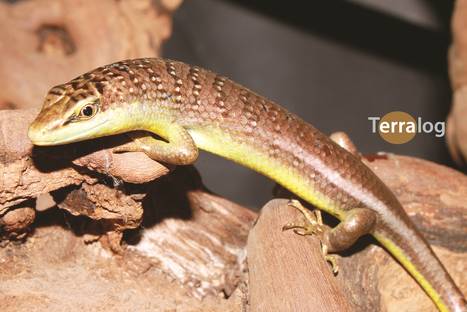
Problem-free feeding
Tree skinks have no special requirements when it comes to feeding. All the usual food insects are accepted happily. They should always be dusted with a calcium- vitamin mix. In addition it is highly advisable to fit a UV lamp in the terrarium.
Sexual dimorphism
As with very many lizards, male tree skinks can readily be identified by their thickened hemipenis sacs. In the Emerald Tree Skink there is a further reliable difference between the sexes: males have a large, strikingly colored (yellow or orange) scale on the underside of the thigh, as well as yellow scales on the heels. These egg-laying lizards are fairly tolerant of one another, including the males – something that cannot be taken for granted in skinks!
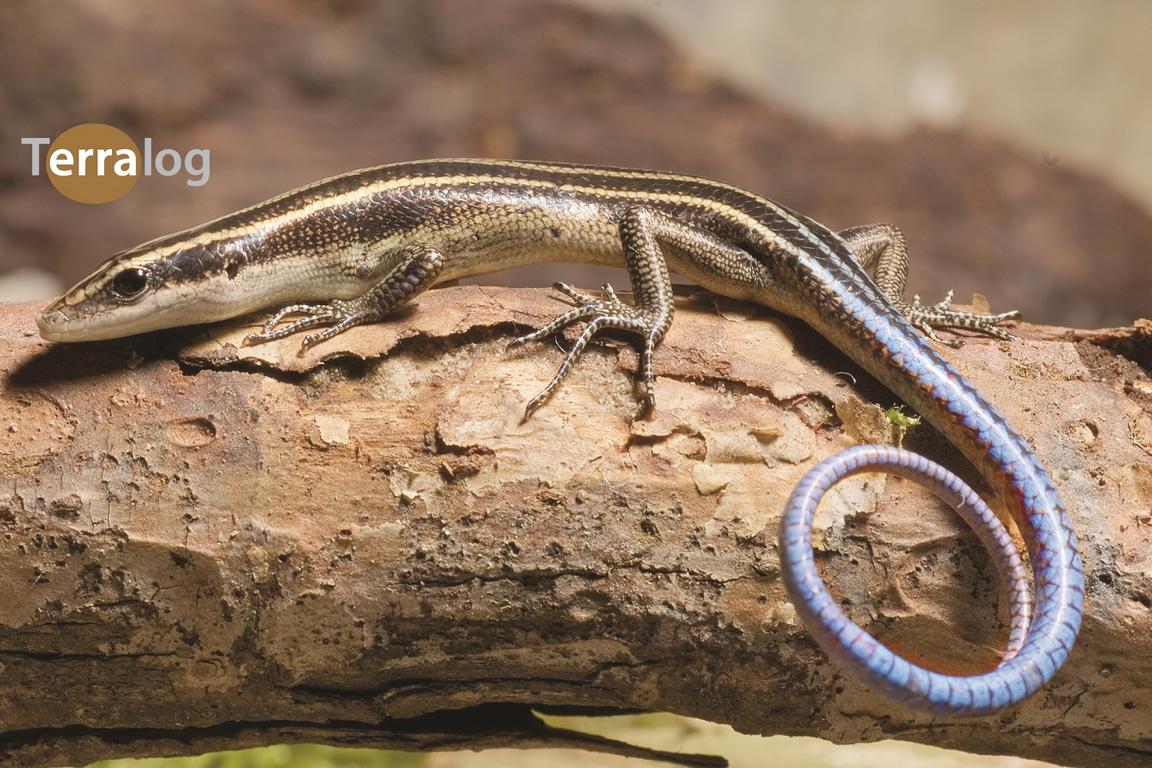
Island-hopping dwarf skinks
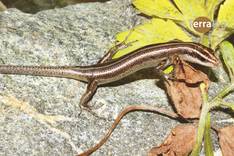 The dainty blue-tailed dwarf skinks of the genus Emoia are a quite different kettle of fish. There are two sibling species that cannot be told apart on the basis of appearance alone, specifically E. cyanura and E. impar. They also occur in the same geographical areas, so that in this case the source of the lizards is unfortunately no help. It is, however, very important to distinguish between them, as E. cyanura is an inhabitant of open terrain and E. impar lives in woodland. This means that E. cyanura has a higher temperature requirement than E. impar. The best solution is to initially house these little reptiles (the head-body length measures 4-6 cm, plus the tail, which is much longer than the body) in a relatively large terrarium and provide various “sunny” spots. Once you know what temperature range the lizards prefer to seek out in order to achieve their “working temperature”, these conditions can be reproduced in a smaller terrarium, if desired.
The dainty blue-tailed dwarf skinks of the genus Emoia are a quite different kettle of fish. There are two sibling species that cannot be told apart on the basis of appearance alone, specifically E. cyanura and E. impar. They also occur in the same geographical areas, so that in this case the source of the lizards is unfortunately no help. It is, however, very important to distinguish between them, as E. cyanura is an inhabitant of open terrain and E. impar lives in woodland. This means that E. cyanura has a higher temperature requirement than E. impar. The best solution is to initially house these little reptiles (the head-body length measures 4-6 cm, plus the tail, which is much longer than the body) in a relatively large terrarium and provide various “sunny” spots. Once you know what temperature range the lizards prefer to seek out in order to achieve their “working temperature”, these conditions can be reproduced in a smaller terrarium, if desired.
Emoia cyanura is one of the commonest lizards of the Pacific islands and is found on practically every island as long as it has an area of more than around a hectare. It is thus a true island-hopper, as it can be found everywhere from the Bismarck Islands in the west to Polynesia in the east.
Reproduction takes place via two eggs, which can be laid at any time of the year. These little lizards aren’t tied to any particular biotope, but are not found in woodland. They are not territorial, but run around everywhere. The “working temperature” of Emoia cyanura begins at around 24.5 °C, and when sunbathing they warm up to more than 30 °C.
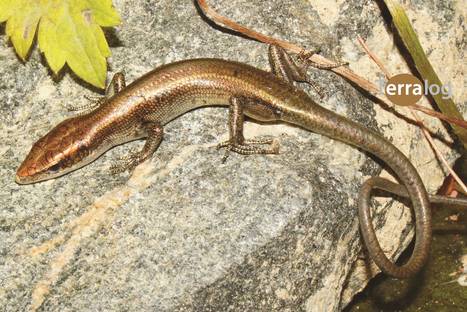
Another globetrotter
The final skink to be briefly presented here is another globetrotter, and is found practically everywhere in South-East Asia, even in the center of metropolises like Hanoi.
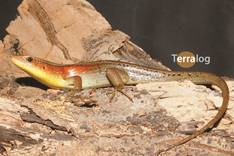
The name of this attractive skink is Mabuya multifasciata, and it can attain a total length of some 30 cm, with the tail being only slightly longer than the body. But nevertheless its maintenance isn’t exactly easy, something that those who keep animals frequently discover when they try to keep extremely common species. Often species that are rare in the wild present far fewer problems. The most important point to bear in mind in the case of Mabuya multifasciata is that it needs to be kept moist and not too warm. The fundamental requirements for enjoying Mabuya multifasciata are a large container of water (this can occupy up to 50% of the bottom area of the terrarium), a spotlamp heating only a very localized area to around 35 °C, and otherwise a temperature between 20 and 25 °C.
This skink is a livebearer (ovoviviparous), i.e. the young hatch at the moment the eggs are laid. In addition to the usual insects, this skink also enjoys feeding on sweet, mushy fruit.
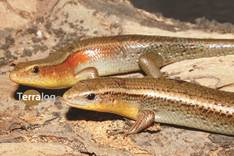
Anzeige






